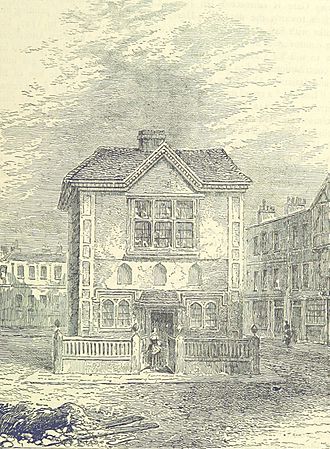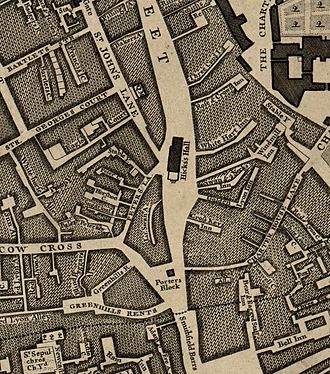Hicks Hall facts for kids
Hicks Hall was an important building in London that served as a courthouse. It was built in 1612 and stood for about 170 years before being taken down in 1782. It was the first building made just for the "justices of the peace" (like local judges) in the area of Middlesex, which included parts of London like the City of Westminster. This is where many important legal cases were heard, from smaller issues to more serious ones. Hicks Hall was also famous because it marked the very beginning of the Great North Road, a major route from London to places like York and Edinburgh. It was the official starting point for measuring distances along that road.
Contents
Where Was Hicks Hall?
For many years before Hicks Hall was built, the local judges of Middlesex would meet in inns (like hotels or pubs) at the southern end of St John Street. This area was very close to the City of London, just north of a tollgate called Smithfield Bar. They used two different inns at various times: the Castle and the Windmill.
Around the 1570s, Queen Elizabeth I even thought about building a proper courthouse here. She gave some land for it, but the project never happened.
Building Hicks Hall
In 1609, the judges asked King James I for a new place to hold their court sessions. This time, their request was approved, and the building was finished in 1612.
The chosen spot was a small island in the middle of St John Street, right across from the Windmill inn. It was paid for by a very rich merchant named Sir Baptist Hicks. He later became Viscount Campden. Because he paid for the building, the judges decided to name it "Hicks-hall" in his honor. This happened at the very first court session held there in January 1613.
For 170 years, Hicks Hall was a busy place where many court cases for Middlesex were heard. For example, in 1660, a special jury met here to begin the trials of 29 men who had signed the death warrant for King Charles I. Later, in 1679, a man named Titus Oates gave evidence here about a supposed plot against James, Duke of York. In 1683, William, Lord Russell was sentenced to death after his trial for being involved in a plot against the king.
The famous diarist Samuel Pepys even mentioned Hicks Hall in his diary on December 6, 1660. He wrote that he was asked to attend a meeting of the Middlesex judges there, but he wasn't sure if he could make it.
The original plan for Hicks Hall was to also include a small prison to help with overcrowding at Newgate Prison. However, the space was too small, so they only managed to build a smaller holding cell instead.
End of Hicks Hall
By the 1770s, St John Street had become very busy and noisy, which made it hard to hold court sessions. The building itself was also getting old and needed repairs. After some discussion, it was decided that instead of fixing it, the hall would be closed and taken down in 1782.
The court sessions then moved to a new building called the Middlesex Sessions House on Clerkenwell Green. This new building was sometimes also called "Hicks Hall" by people. The Middlesex Sessions House eventually closed in 1921, and cases moved to another courthouse in Newington.
Hicks Hall's Lasting Mark
Inside Hicks Hall, there was a special carved wooden fireplace that honored Sir Baptist Hicks for his gift. When the building was torn down, this fireplace was moved first to the Clerkenwell Green Sessions House, and then to the Sessions House in Newington, where it still exists today! It has an inscription that says:
Sir Baptist Hickes of Kensington in the County of Middlesex Knight one of the justices of the peace of this county of Middlesex of his worthy disposition and at his own proper charge buylt this session house in the year of our Lord God 1612 and gave it to the justices of peace of this county and their successors for a sessions house for ever. 1618.
Even though the building is gone, you can still see where Hicks Hall used to be. It's a wide, open space in the middle of St John Street, where the buildings on either side spread out to make room for two separate paths. In the late 1800s, public toilets were built on this island, which people at the time described as "more useful, but less dignified" than the old courthouse.
Starting Point for Roads
Hicks Hall was the official starting point for the Great North Road. Distances along this road were measured from the front of the building. Even after Hicks Hall was demolished, its location continued to be used for this purpose until the early 1800s. After that, Charing Cross (specifically the statue of Charles I there) became the new official center of London, and all distances from London were measured from that point instead. However, even into the late 1800s, you could still find milestones on the Great North Road that said how many miles it was "from Hicks Hall" or "from where Hicks Hall formerly stood."




